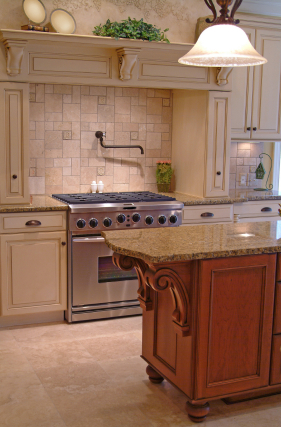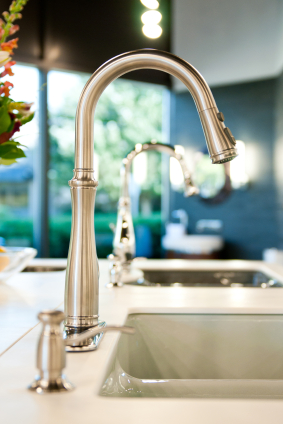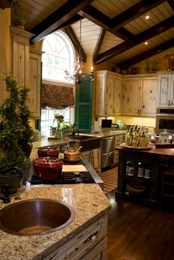Drywall is perhaps the one pre-finish stage of construction that takes the longest and shows the least progress and it's timeframe. While drywall panels are relatively easy to manipulate and put in place, the numerous joints between the panels in the divots made for nails and screws must be filled and smoothed out to create a flat, seamless service for the eventual wall and ceiling finishes.
The first phase, hanging the drywall, takes the average three-person home remodeling crew about three or four days to complete, less so on simply designed homes or with more crewmembers. Most drywall panels need to be cut to accommodate windows and door openings, corners, arches and other features.
The panels also need to be nailed or screwed to be houses frame, with the edges of two panels often sharing a narrow stud. Where there is no stud or other structural member for securing the edge of a panel, some manufacturers offer metal clips that stabilize the drywall. Emailing pattern for drywall is typically 6 inches between nails or screws along the perimeter of each panel and 8 inches with the field of each panel. Once the drywall is hung in place, however, the interior of your home takes on a more realistic appearance.
No longer are you distracted by views through wall studs, now blocked by the drywall. You get a real, tangible sense of the width of your hallways and door openings, and a more clear idea about where furniture and artwork might go to cover these blank walls.
Unfortunately, if you visit the house again within a week or so, not much will have changed that you'll immediately notice. The next two phases of drywall installation, tape and texture, are slow moving. Simply, the wet compound, used to bridge the joints between drywall panels, cover fasteners and create finished quarters, needs to drive, be sanded and reapplied a few times before the walls are adequately smooth and seamless.
The initial but being in taping of joints, fasteners and quarters takes about a day or two. Then strips of paper are sent into a swath of joint compound along the length of each panel connection is a bridge to mitigate cracks and then are pressed tightly along the bud vase, securing it along the joint and squeezing the excess to either side of the tape. The excess is then scraped off and used as needed.
The first phase, hanging the drywall, takes the average three-person home remodeling crew about three or four days to complete, less so on simply designed homes or with more crewmembers. Most drywall panels need to be cut to accommodate windows and door openings, corners, arches and other features.
The panels also need to be nailed or screwed to be houses frame, with the edges of two panels often sharing a narrow stud. Where there is no stud or other structural member for securing the edge of a panel, some manufacturers offer metal clips that stabilize the drywall. Emailing pattern for drywall is typically 6 inches between nails or screws along the perimeter of each panel and 8 inches with the field of each panel. Once the drywall is hung in place, however, the interior of your home takes on a more realistic appearance.
No longer are you distracted by views through wall studs, now blocked by the drywall. You get a real, tangible sense of the width of your hallways and door openings, and a more clear idea about where furniture and artwork might go to cover these blank walls.
Unfortunately, if you visit the house again within a week or so, not much will have changed that you'll immediately notice. The next two phases of drywall installation, tape and texture, are slow moving. Simply, the wet compound, used to bridge the joints between drywall panels, cover fasteners and create finished quarters, needs to drive, be sanded and reapplied a few times before the walls are adequately smooth and seamless.
The initial but being in taping of joints, fasteners and quarters takes about a day or two. Then strips of paper are sent into a swath of joint compound along the length of each panel connection is a bridge to mitigate cracks and then are pressed tightly along the bud vase, securing it along the joint and squeezing the excess to either side of the tape. The excess is then scraped off and used as needed.
At corners, sections of thin sheet metal, folded into Charlotte or curved corners, Rdio into the framing, then covered over by the joint compound to hide the connection. Once completed, this stage of drywall is allowed to drive for a day. Occasionally, especially where a thick coat of compound was required, you might see small cracks. Not to worry, such cracks will be filled by the next layer of joint compound. Once dry, the buddies sanded smooth, and wiped clean to eliminate any dust particles on the drywall. That's that alone can take a full day or more, including cleanup.
Subsequent layers of joint compound, each progressively thinner, are needed to float out or flatten any areas of the wall service that aren't smooth or flushed to the rest of the wall. How many layers depends on the construction of the walls in the initial drywall installation. No matter how many, each application of joint compound must be allowed to dry thoroughly and be sanded in wiped down for the next layer. Count on at least two days for each cycle of joint compound application.
In many cases, the last step of drywall installation is texturing. Generally, texturing refers to the progressive steps towards a smooth wall. But it also refers to having a blast later once the wall is smooth and seamless. In that case, the builder or drywall contractor may add dimensions to the wall or ceiling.
Dimension divorce move, when the walls are deemed ready for finish they don't appear to look much different than just after the initial drywall installation, a step that may have occurred a week ago or more. Get used to that feeling is your remodeling project nears completion.
Subsequent layers of joint compound, each progressively thinner, are needed to float out or flatten any areas of the wall service that aren't smooth or flushed to the rest of the wall. How many layers depends on the construction of the walls in the initial drywall installation. No matter how many, each application of joint compound must be allowed to dry thoroughly and be sanded in wiped down for the next layer. Count on at least two days for each cycle of joint compound application.
In many cases, the last step of drywall installation is texturing. Generally, texturing refers to the progressive steps towards a smooth wall. But it also refers to having a blast later once the wall is smooth and seamless. In that case, the builder or drywall contractor may add dimensions to the wall or ceiling.
Dimension divorce move, when the walls are deemed ready for finish they don't appear to look much different than just after the initial drywall installation, a step that may have occurred a week ago or more. Get used to that feeling is your remodeling project nears completion.




 RSS Feed
RSS Feed

